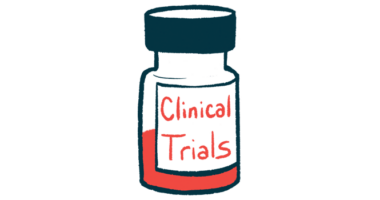Blood test may help track response to SMA treatment Evrysdi
Study finds SMN protein in blood cells mirrors treatment's effectiveness

Measuring the levels of the survival motor neuron (SMN) protein in blood cells may help track spinal muscular atrophy (SMA) patients’ response to Evrysdi (risdiplam), a study from Japan found.
Patients taking the drug showed a significant increase in blood levels of SMN after one month of therapy. SMN levels fluctuated over the next year, but stayed above starting levels. Motor function improved significantly five months after starting treatment.
The results show “SMN protein is an appropriate biomarker for monitoring and evaluating the efficacy of [Evrysdi] treatment in SMA,” the researchers wrote.
The study, “Survival motor neuron protein is the optimal biomarker for evaluating the risdiplam treatment,” was published in Brain and Development.
SMA is caused in most cases by mutations in the SMN1 gene, which contains instructions to produce the protein SMN. In SMA, the lack of SMN protein causes motor neurons — the specialized nerve cells that control movement — to gradually sicken, or degenerate, and die off. This results in SMA symptoms such as muscle weakness and wasting.
Biomarkers needed
SMA types are defined depending on the severity and when symptoms begin manifesting. In SMA type 1, a severe form of the disease, symptoms develop within the first six months of life. People with SMA type 2 typically have slightly less severe symptoms appearing between the ages of 6 and 18 months, while people with SMA type 3 don’t develop symptoms until later in childhood or adolescence.
Evrysdi is a daily disease-modifying therapy available as a flavored liquid in a solution or oral tablet. It targets the SMN2 gene, which, like SMN1, contains instructions for cells to make SMN. Normally, a process called splicing leads to the generation of a shorter, less stable, and poorly working SMN protein from SMN2. Evrysdi corrects the gene’s splicing to increase the functional SMN made from SMN2.
Despite recent treatment advances in SMA, clinicians still need ways to monitor treatment response that is reliable throughout a patient’s life and independent of disease severity. “There is an increasing need for biomarkers to facilitate decision-making during the clinical course of disease and as objective measures of therapeutic intervention,” the researchers wrote.
The team previously developed a technique to measure SMN using blood samples. In the latest study, they applied this technique in people with SMA receiving Evrysdi, looking at motor function, electrophysiological testing (focusing on muscle cell activity), and blood tests.
They looked at 25 patients ranging in age from 6 months to 68. Most had SMA type 2 or 3 and were able to sit. One had SMA type 1. Twelve participants had previously received another SMA therapy: 11 had received Spinraza (nusinersen) and one had received Zolgensma (onasemnogene abeparvovec-xioi).
Follow-up visits occurred about one, two, five, eight, and 12 months after starting the therapy.
Among the participants who experienced clear improvement, one had previously lost the ability to move their head and needed a nasogastric tube for nutritional support. “The patient regained head control within one month of treatment initiation and no longer required a nasogastric tube after four months,” the researchers wrote.
Improvements in motor skills as measured by the Hammersmith Functional Motor Scale Expanded (HFMSE) became statistically significant eight months into Evrysdi. At this point, all participants saw significant improvement in electrophysiological examinations. Benefits were also found in measures of upper limb function and of exercise capacity.
Median SMN levels rose significantly after one month of therapy. Fourteen participants showed a threefold or greater increase, and another eight had a fivefold or higher increase. The improvement was maintained throughout the 12 months of the study.
“There may be a mechanism by which SMN protein expression [production] increases after [Evrysdi] is initiated, but then degrades, decreases, and subsequently stabilizes,” the researchers noted.
However, three participants who adhered to the treatment regimen showed clear decreases in SMA levels at a specific time point relative to before starting on Evrysdi. This could be because the medication didn’t successfully increase production of functional SMN, or it could be a limitation of the measurement technique, according to the team.
“Because this study is in a heterogeneous population with different severity types, it is difficult to say only from the present results alone that measurement of SMN protein levels is a useful marker by itself to assess the efficacy of [Evrysdi],” the researchers wrote.
Overall, “measurement of SMN protein may be an indicator of tolerability and medication adherence as well as a measure of treatment response. In individuals who are less likely to show clear clinical improvement, exhibiting increased SMN protein may motivate them to continue treatment,” the team concluded.








